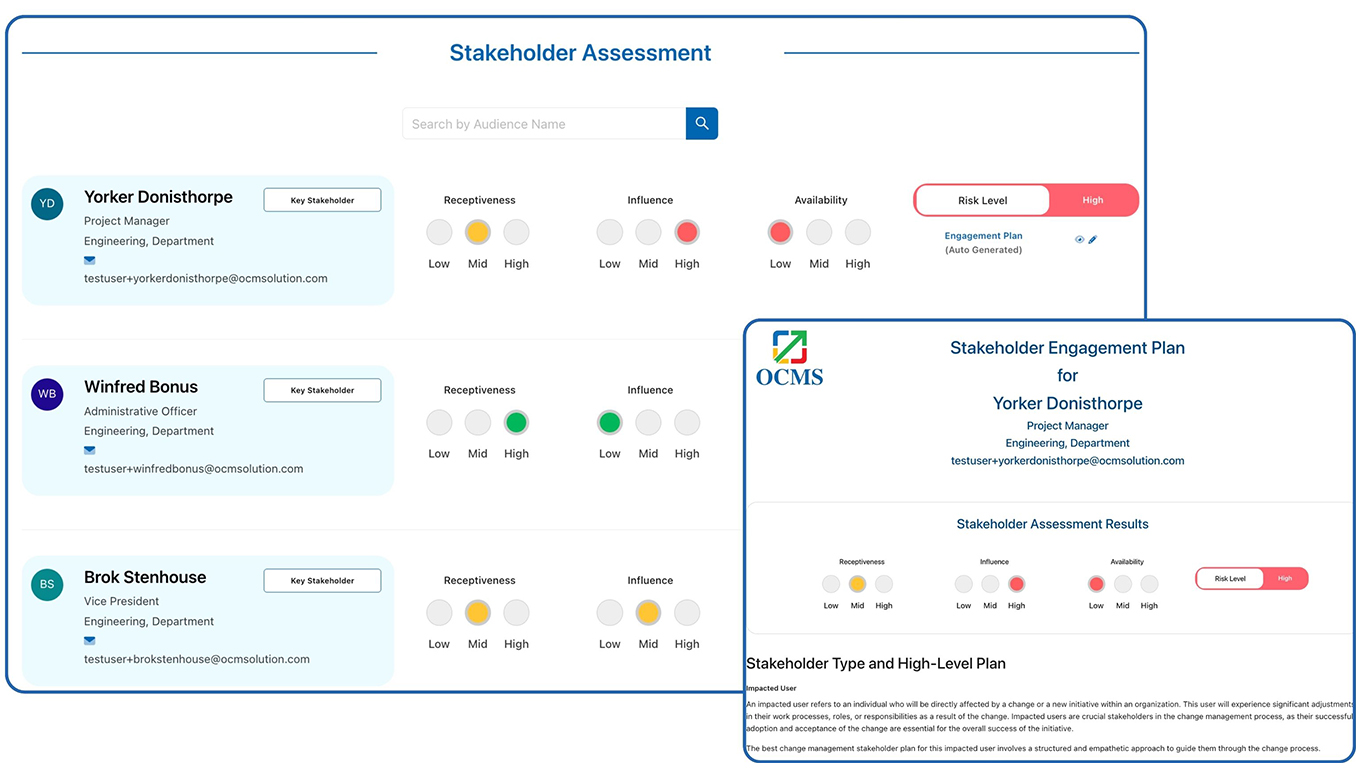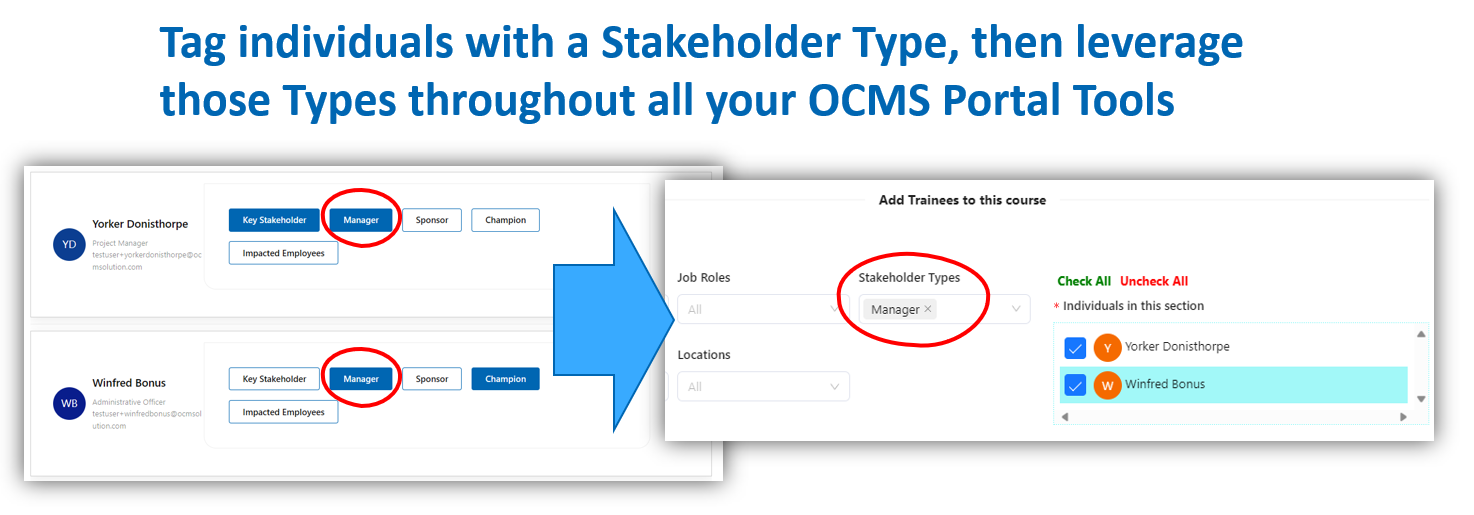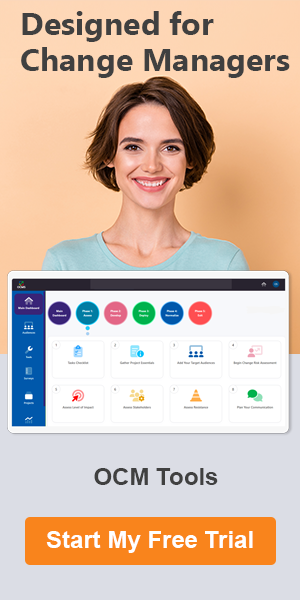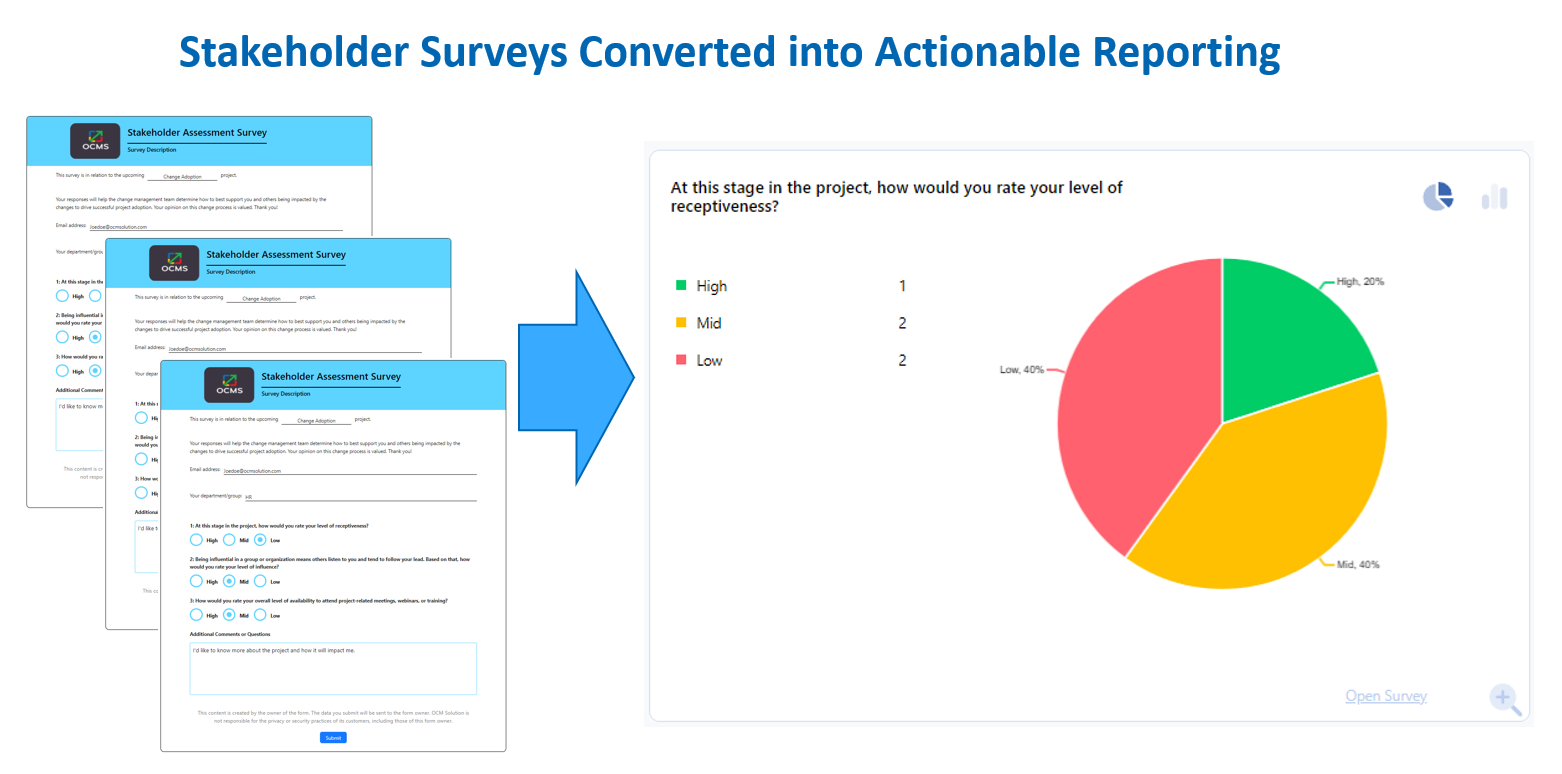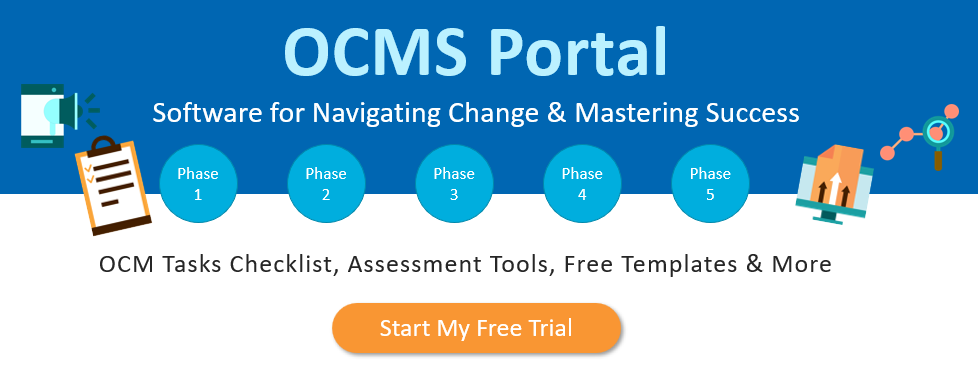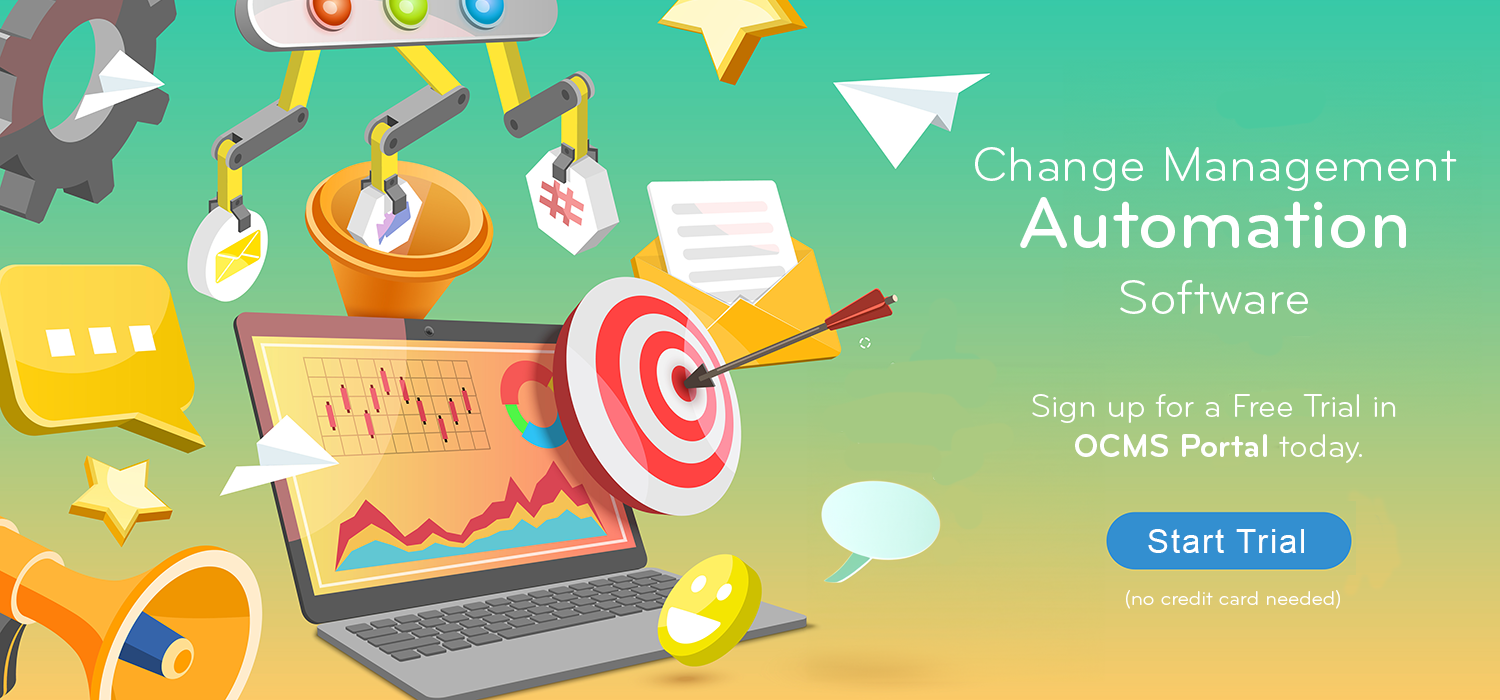Best Guide to Conducting and Delivering Stakeholder Assessment, Mapping & Analysis
Welcome to the World of Stakeholder Engagement Analysis!
In this article, we’re diving into a topic that’s often the secret sauce behind successful initiatives: stakeholder analysis and mapping. Imagine your project as a vibrant ecosystem, where every player has a role and every action creates ripples. Stakeholders, those key individuals and groups invested in your project’s success, are the heartbeats of this ecosystem.
Understanding the needs, expectations, and concerns of project stakeholders isn’t just useful—it’s absolutely vital.
Why is project stakeholder assessment and mapping so crucial? Well, think of it as your project’s compass, guiding you through the maze of challenges and ensuring everyone’s on board for the journey. By identifying who your stakeholders are, what they care about, and how they can influence your project, you’re not just ticking off a checklist; you’re laying the foundation for a smooth, cooperative, and ultimately triumphant endeavor.
In a hurry? Check out our quick summary next. Want to dive into more details? Keep reading for a deeper dive into the topic of stakeholder engagement map creation and analysis.
Quick Summary
Stakeholder Mapping Definition
Creating a stakeholder management map is a fundamental process aimed at identifying key individuals and groups with a vested interest in a project, program, or transformative change. This assessment involves pinpointing managers, business leaders, employees, and influential parties affected by the initiative.
While some organizations may include every employee in their stakeholder analysis, it’s common to focus on “key stakeholders” such as department leaders, team representatives, and change sponsors, ensuring a diverse representation across all levels of the organization. Moreover, stakeholders aren’t limited to internal staff; external entities like vendors and major customers impacted by the change are also crucial considerations for a stakeholder map design process.
A stakeholder analysis definition includes a mapping process that helps guarantee the inclusion of all necessary stakeholders from various impacted groups. A comprehensive list can include managers, senior executives, business leaders, specific job roles, and employees who have a significant influence on the project.
Streamline Your Stakeholder Identification and Analysis with OCMS Portal.
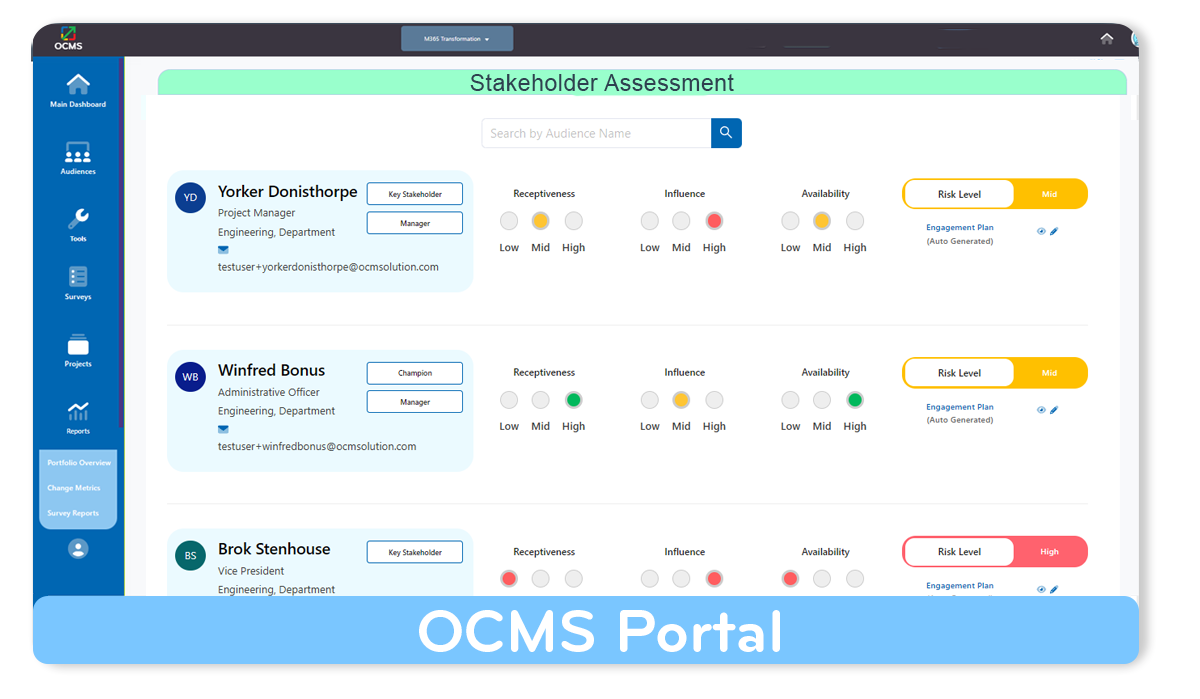
Smart stakeholder map design thinking with software that automates the process! Sign up for a free trial of OCMS Portal today for instant access to a stakeholder analysis change management tool, plus many other tools and templates.
Why is Stakeholder Engagement Important?
Effective stakeholder engagement is crucial for the success of any change management project. Stakeholders, with their varying levels of support or resistance and influence over others, can significantly impact the outcome.
Identifying willing stakeholders is essential for driving the project forward and managing resistance effectively. Stakeholder analysis, assessment, and management are pivotal activities in the change management process.
Categorizing stakeholders based on their roles, such as sponsors, impacted executives, senior managers, change champions, super users, or influencers, enables strategic planning.
This stakeholder analysis grid approach ensures targeted engagement activities, enhancing the project’s overall effectiveness. Stakeholder mapping templates like the one in the OCMS Portal change management software with designated tags for stakeholder types facilitate easy identification of stakeholders, streamlining the process.
OCMS Portal’s Stakeholder Tool with Stakeholder Type Mapping
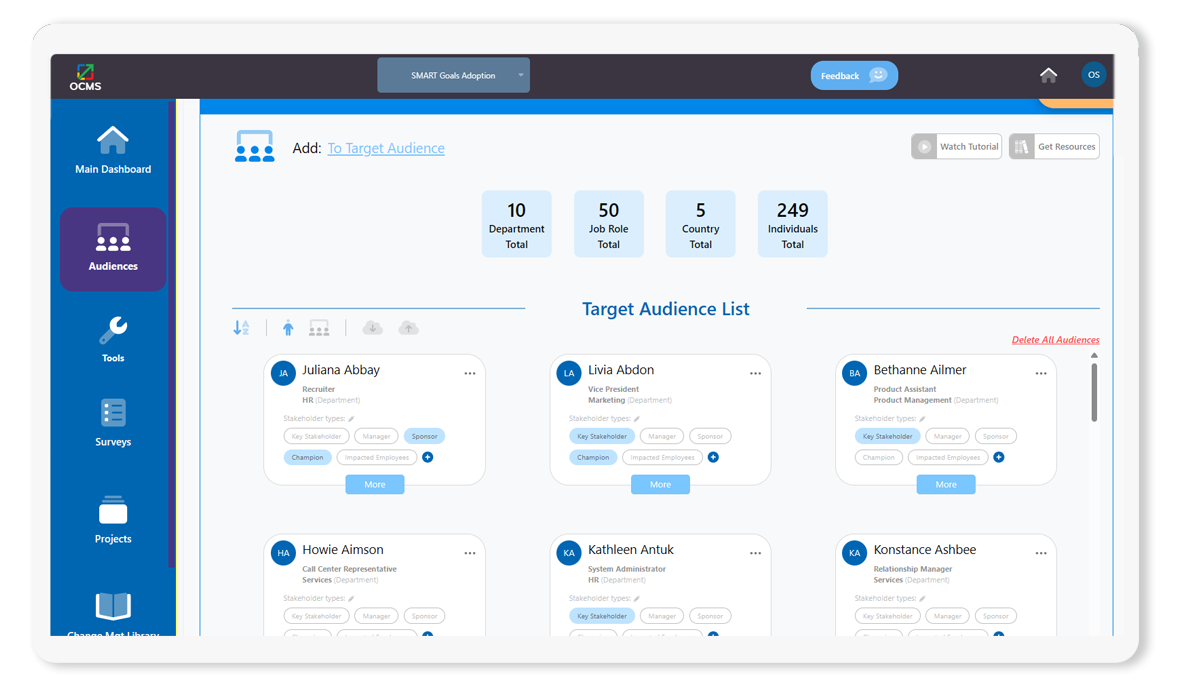
Stakeholder Mapping Process Overview
In the project stakeholder map process, focusing on specific representatives of stakeholder groups and key individuals is essential, especially in larger organizations.
This involves identifying:
- Decision-makers
- Change sponsors
- Employee representatives from affected departments
- Contractor/vendor representatives
- Customer representatives (if applicable)
- Change Champions/Agents
- Department heads/managers
- Other relevant representatives from impacted groups or job roles
This comprehensive list, known as the “Universal List of Stakeholders,” is crucial for effective stakeholder analysis and management.
To create a robust stakeholder mapping template, it’s important to document various stakeholder details, including their roles, organizational affiliations, locations, and stakeholder type (sponsor, key stakeholder, manager, etc.). Collaborating with project teams, program managers, sponsors, and subject matter experts aids in identifying key stakeholders, ensuring a thorough analysis.
Do you have any questions about stakeholder analysis marketing, the importance of stakeholder analysis in project management, a stakeholders assessment matrix, or a stakeholder analysis Excel? Please reach out and let us know.
Steps for Stakeholder Analysis
Once stakeholders are mapped, it’s important to do an analysis of their receptiveness to the project, level of influences, and other additional factors that will help you understand their risk level (such as availability). A high risk level means that the stakeholder is at high risk of failing to successfully adopt the changes required by the project.
The purpose of stakeholder mapping is to help you categorize the stakeholders, then you’ll do a stakeholder engagement assessment to understand their risk level. The higher the risk level, the more engagement is needed by the OCM team.
Following are stakeholder mapping steps and analysis steps:
- Identify Stakeholder Types:
- Classify stakeholders by type (e.g., change agent, executive, manager) using a stakeholder analysis tool like the one in the OCMS Portal.
- Assess Ability to Impact the Project:
- Identify and map each stakeholder’s ability to impact the project, informing engagement plans and prioritization. Address opposition from influential stakeholders promptly to gain buy-in and prevent project setbacks.
- Assess Level of Receptiveness:
- Gauge stakeholders’ receptiveness to the project using a scale to determine their support level. This information, when cross-referenced with their ability to impact the project, identifies critical stakeholders. Proactively engage with stakeholders having high impact but low support to secure project success.
- Assess Availability:
- Assess stakeholders’ availability for change-related activities, such as engagement, coaching, and training. Tailor engagement strategies based on stakeholders’ bandwidth, ensuring efficient planning. Respecting stakeholders’ busy schedules and accommodating their availability enhances cooperation and task accomplishment.
Stakeholder Analysis Strategy & Plan
After assessing stakeholders, the next step in a stakeholder mapping business process involves planning engagement strategies and tasks. These tasks can include meeting with stakeholders’ supervisors to allocate time for training sessions, gathering specific points to show the benefits of the change to the individual, and conducting one-on-one sessions to address concerns.
Start with a simple stakeholder analysis plan based on the individual’s assessment factors (level of influence, receptiveness, availability, etc. If you use the OCMS Portal’s stakeholder analysis software, then once you finish an assessment, the system will automatically generate a stakeholder analysis and engagement plan for you.
Stakeholder assessment and stakeholder matrix mapping example with autogenerated engagement plan from the OCMS Portal’s online stakeholder mapping tool. Learn more about it here.
Conclusion: Stakeholder Mapping Meaning
In wrapping up our exploration of stakeholder analysis and mapping, it’s clear that understanding your project’s influencers is the key to unlocking its full potential. By delving into the unique needs of stakeholders, you’re not just ensuring their support; you’re building a community of cheerleaders for your project.
Remember, key stakeholder analysis isn’t a one-time task but an ongoing conversation. Continuously reassess, communicate, and adapt your strategies as your project evolves. Embrace the insights gained here, and watch how your projects transform from mere tasks into collaborative achievements, making a real impact on your organization and beyond.
Detailed Deep Dive
The Complete Guide to Stakeholder Analysis & Mapping – Everything You Need
Published for Project Managers, Change Management Practitioners, Program Managers, and Change Leads, this free guide provides you with everything you need to know about the best change management stakeholder mapping framework for projects.
It provides a step-by-step walkthrough of key stakeholder mapping activities that you need to complete, and references stakeholder mapping examples, samples, stakeholder analysis templates, stakeholder plan matrix, and change tools that you can use for your needs.
This guide is designed for practitioners in any industry, including healthcare, construction, business, finance, corporate, retail, professional services and more.

Sample stakeholder engagement assessment matrix | streamlined stakeholder analysis grid in the OCMS Portal software
Stakeholders can make or break a change management project depending upon whether they support or resist the change and what influence they may have on other stakeholders. Stakeholders are also vital to driving your change project forward, so it’s important to identify those stakeholders that are willing to help.
All this makes stakeholder analysis, assessment, and management one of the most important activities performed during the change management process. Whether you use a stakeholder mapping template Excel sheet or cloud-based stakeholder analysis chart, it’s one of the first things you’ll do after your initial change impacts assessment.
Certain stakeholders will need to be engaged on a regular basis throughout the project, while other stakeholders will need to be invited to be part of the Change Champions Network to help increase the success of the project. Some stakeholders will need to be coached or included as key allies in your resistance management strategy.
A stakeholder analysis diagram or map helps you understand the makeup of the impacted stakeholders (which are key stakeholders within the target audience list) so you can understand how to best engage with them. These can then be used in a stakeholder analysis presentation when presenting your strategic playbook.
See Also: Stakeholder Engagement and Management Guide.
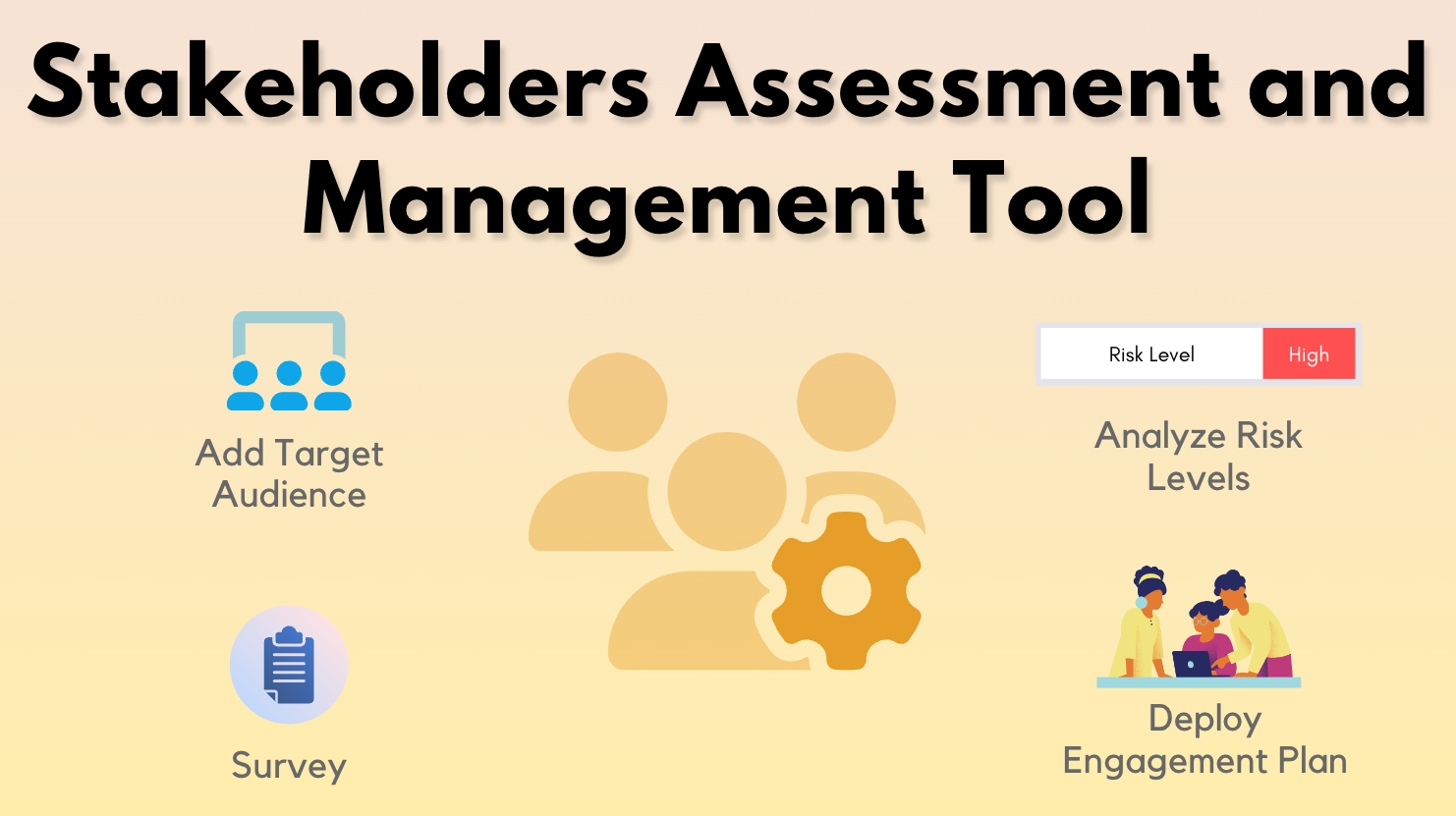
OCMS Portal’s Stakeholder Assessment Template gives you everything you need to map, assess, and management stakeholders for a project. Sign up for a free trial today for instant access.
See also: OCMS Portal with best stakeholder mapping templates for creating a stakeholder map.
Are there other stakeholder mapping examples you would like to see listed in this guide, including stakeholder analysis in healthcare or other industries, project stakeholder analysis example, or stakeholder analysis example for project management? Please reach out and let us know.
Table of Contents – Everything You Need for Effective Stakeholder Analysis, Mapping & Assessments
Keep on scrolling down this page to read each section or click any link below to go directly to that section.
1. Should You Use a Stakeholder Matrix Tool?
2. Increasing the Successes of Your Project Stakeholder Analysis
3. Quick Overview – What You Need to Know
4. During Which Phase of Your Project Should You Conduct a Stakeholder Analysis?
5. What is Stakeholder Analysis? Stakeholder Assessment Definition
6. What is Stakeholder Mapping?
7. Stakeholder Analysis Process: Key Steps
8. Step-by-Step Process for Identifying Stakeholders
9. Stakeholder Mapping Matrix
10. Why Stakeholder Mapping is Important
11. Determine the WIIFM for Each Stakeholder/Group
12. Planned Tasks & Strategy for Engaging Stakeholders
13. Why You Should Coach Key Stakeholders and Sponsors
14. Engage and Manage Stakeholders
15. How Do You Measure Stakeholder Support, Availability, Etc.?
16. Change Management Stakeholder Assessment Tool & Templates
Do you have any questions about the stakeholder map template referenced in this guide? Do you have additional stakeholder analysis examples you would like to see listed in this guide, that can help other program managers and change practitioners conduct their own stakeholder analysis in project management, including stakeholder mapping example in healthcare, finance, professional services, or other sectors? If so, please reach out and let us know.
Should You Use a Stakeholder Matrix Tool (Also Known as a Stakeholder Mapping Tool)?
When conducting stakeholder analysis, project practitioners often use a stakeholder matrix tool to document their stakeholder assessments.
Using a stakeholder matrix is essential as it will provide you with a holistic view of your stakeholder impact analysis. It will also act as a centralized file from which you will be developing and implementing your stakeholder management plans and stakeholder engagement activities.
Organizing your stakeholders into different “types” will help you plan your stakeholder engagement activities accordingly, and if you are using a stakeholder mapping template, it should come with a column that will allow you to flag a stakeholder based on that stakeholder’s types (e.g., is the person a sponsor, an impacted business executive, a senior manager, a change champion/agent, a super user, an influencer, or other?).
The stakeholder mapping example screenshot below outlines a stakeholder assessment matrix in the Target Audience tool of the OCMS Portal that has a Stakeholder Type tag for mapping your stakeholders.
Illustration: stakeholder analysis example with different stakeholder types
Sample stakeholder map template with a streamlined “Stakeholder Type” column. This stakeholder analysis matrix example is part of the OCMS Portal’s target audience tool and stakeholder analysis toolkit and can be leveraged when planning communications, assessing readiness, and much more! Get a free trial to see it in action for yourself.
Reach out to us if you have feedback on other best stakeholder mapping templates free or paid that you have used in the past, including healthcare stakeholder map templates, financial services mapping, construction stakeholder mapping, retail stakeholders, example of stakeholder analysis in healthcare, and other types of project stakeholder assessments.
Increasing the Successes of Your Project Stakeholder Analysis
As a Senior Change Management Consultant, I have delivered global transformations that impacted thousands of employees and customers across Intel, Apple, Capital One, Accenture, HSBC, Deloitte, and other firms.
A decade after Steve Jobs handed the reins of leadership at Apple to Tim Cook, I was hired to create Apple’s first-ever B2B Change Management Practice.
During my tenure in organizational change management and program implementation, I have discovered that applying the stakeholder analysis model and best practices described below increases the success of change implementation by an additional 82% on average.
Ogbe Airiodion
Senior Change Management Program Manager
Don’t Miss: Stakeholder analysis templates to use in the OCMS Portal.
Please reach out if you have any questions about stakeholder mapping methodology, stakeholder analysis for change management, stakeholder analysis in strategic management, six sigma stakeholder analysis template, or an example of stakeholder analysis in healthcare.
What is the Importance of Stakeholder Analysis?
Why is stakeholder analysis important? Stakeholder assessment is a critical component of effective business change management because it increases the success of your stakeholder engagement and management. A stakeholders engagement assessment matrix is used to map key performance indicators that help you understand the type of change management engagement needed.
Mapping and assessing stakeholders are also important because they are fundamental activities for a change management project. Whether you use a stakeholder analysis template excel, stakeholder mapping template word document, or cloud-based free stakeholder map template, it’s important to have a place to document your stakeholder mapping grid.
Output from your stakeholder mapping and analysis will feed into other areas of change management and provide you with a “master list” of key employees, managers, and others that will be impacted by a project.
In addition to identifying key stakeholders in a project, another importance of stakeholder analysis is that it allows you to identify key stakeholder metrics and KPIs, such as:
- Which stakeholders are being impacted the least or most by a change project?
- Where each stakeholder stands on receptiveness to the change.
- Which stakeholders can impact a change project the most?
- The availability level of stakeholders for accomplishing change activities.
This stake holder mapping guide is designed for Project Managers, Change Management Practitioners, HR, Business Analysts, Change Leads, and anyone that has been assigned to conduct an effective stakeholder analysis and mapping and with stakeholder analysis interest.
This free guide provides you with a step-by-step overview of everything you need to know for conducting and increasing the success of your stakeholder analysis, mapping, and assessment, and involves how to identify the who, what, why, and when that is required for an effective stakeholder assessment.
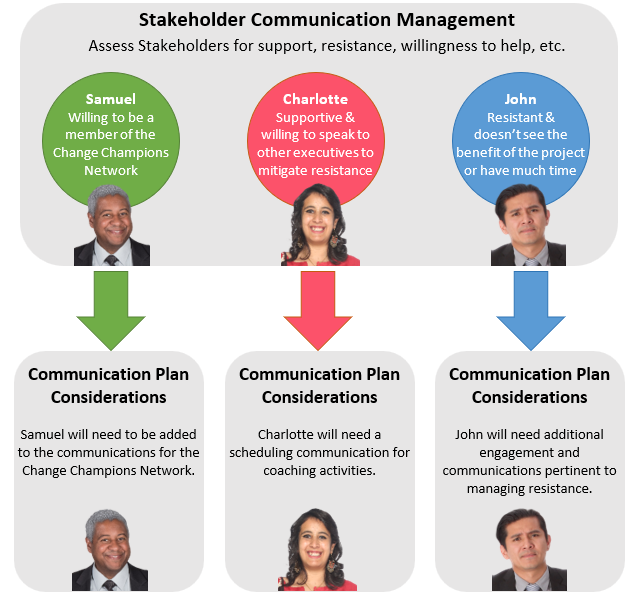
The image above is another example of the importance of stakeholder analysis. It outlines how stakeholder matrix mapping informs other areas of your change management activities, and how to use stakeholder mapping categories.
Do you have any questions about the stakeholder engagement assessment matrix outlined in this guide? Is there a best stakeholder strategy that you have used that you would like to share with other project managers and change leads? Please, reach out and let us know.
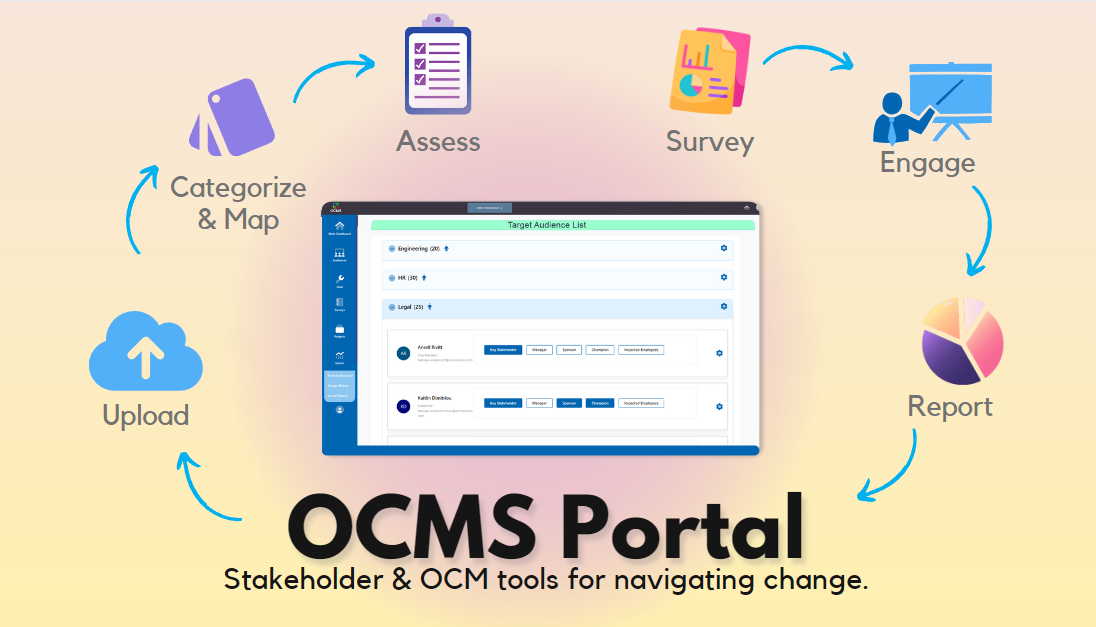
OCMS Portal has easy-to-use stakeholder mapping software that can help you with all types of stakeholder analysis needs. This best template for stakeholder mapping is truly one-of-a-kind! Sign up for a free trial today! (no credit card needed)
Don’t miss: Get your stakeholder mapping tools and start conducting your project stakeholder analysis today with OCMS Portal.
Are there other best stakeholder mapping template Excel or cloud based, including stakeholder analysis in healthcare that you have feedback on? Do you have more questions about a stakeholder map, stakeholder impact analysis template, or a stakeholder analysis grid template? Reach out and let us know.
During Which Phase of Your Project Should You Conduct a Stakeholder Analysis?
If you are following a change model, such as the OCM Solution Change Management Framework, you’ll note that there are typically different change activities performed at different phases of a project.
For example, the OCMS Change Model has five phases:
- Phase 1: Assess
- Phase 2: Develop
- Phase 3: Deploy
- Phase 4: Normalize
- Phase 5: Exit
Your stakeholder analysis steps should be started during Phase 1 when you do your various change assessments.
Stakeholder analysis and stakeholder map of business impact from a change initiative is one of the initial activities that you’ll perform after you’ve identified your impacted groups since your stake holder mapping analysis will drive several other activities that you do in other phases of your change project.
Developing your stakeholder management plan will come in Phase 2 (Develop), and you will execute that plan and actively manage your stakeholders in Phase 3 (Deploy) and Phase 4 (Normalize).
Illustration: Sample Stakeholder Mapping Templates
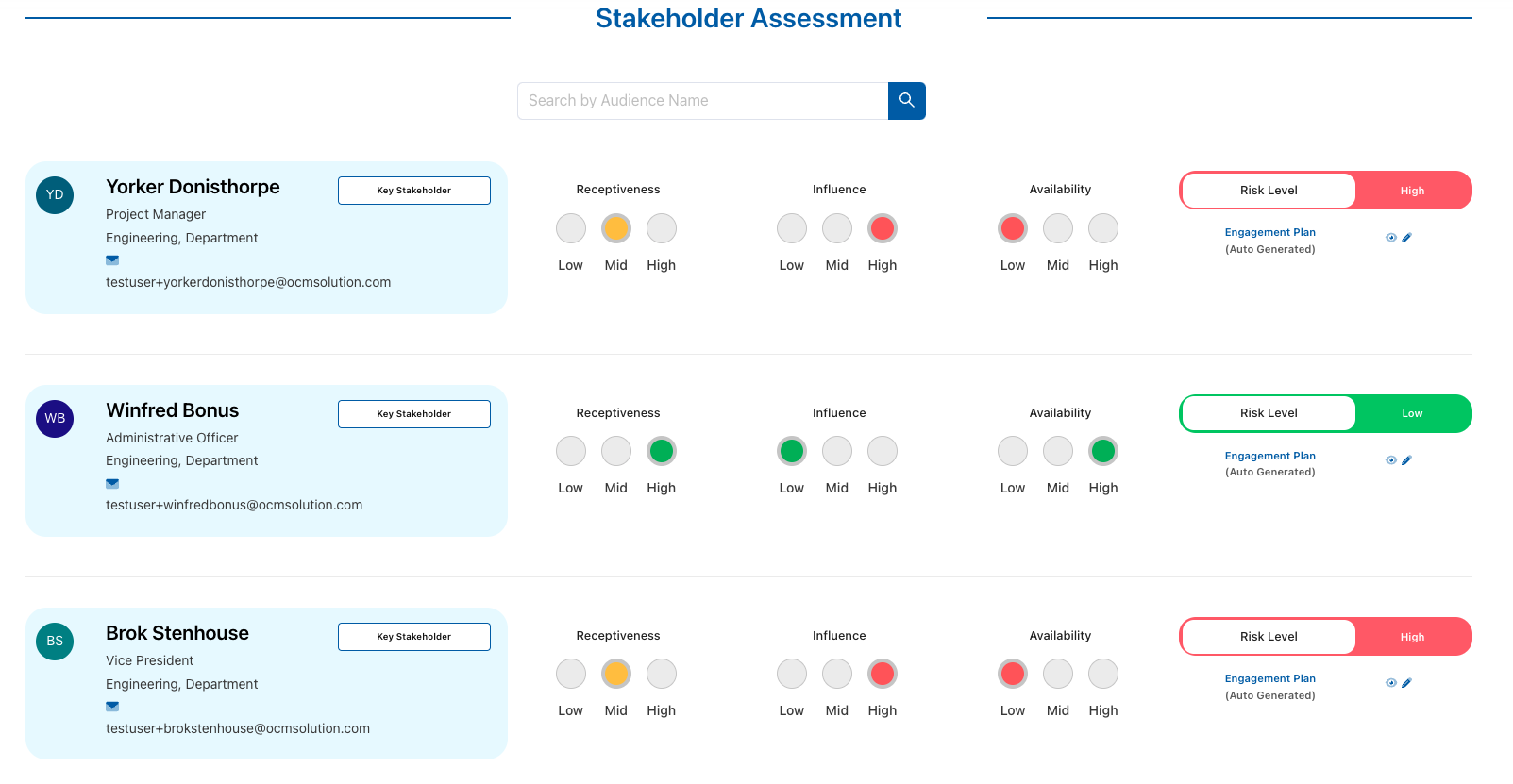
Stakeholder analysis matrix template example in the OCMS Portal
Is there a best stakeholder mapping template in Word, PDF, PowerPoint, or Excel document that you have used that you would like to share with other project managers and change leads? Are you looking for a stakeholder analysis in project management PDF or stakeholder analysis example PDF? Please, reach out and let us know.
See also: OCMS Portal’s change management stakeholder analysis templates for identifying project stakeholders at your organization.
What is Stakeholder Analysis? Stakeholder Assessment Definition
Have you been searching for a good stakeholder analysis meaning? Here’s one that should help.
Stakeholder analysis and assessment is a process used to identify key individuals that have a stake in a project, program, or transformational change. Stakeholder assessment involves identifying managers, business leaders, employees, and groups that will be impacted by a change initiative. The leaders and managers are often referred to as “key stakeholders.”
Your list of stakeholders in your stakeholder analysis and management template will include:
- People & groups who will be impacted by a change project
- People & groups who will be influenced by a change project
- People & groups who may hold influence over a change project
By “stakeholder” do you mean ALL Employees?
In some cases, a Stakeholder Analysis template will list out each employee. However, in the case of an organization with thousands of employees, it’s not quite as feasible to include ALL impacted employees. In this case, the change management team may decide instead to include “key” stakeholders, such as leaders of a department, team representatives, or sponsors of the change in their stakeholder template.
These key stakeholders should represent all areas and levels of an organization being impacted by the change project, so you’ll have a good cross-section of all impacted individuals. This includes impacted divisions, departments, groups, teams, job roles, executives, employees, front-line workers, leadership, etc. How you do stakeholder analysis influences your entire project.
Why not just include all the managers of departments being impacted in your stakeholder analysis? Wouldn’t that be easier?
You would not only want to include managers or leadership of impacted areas in your stakeholder analysis because leaders are impacted differently than employees. If you leave out the representation of an important group of impacted individuals in your stakeholder analysis, you could end up with unexpected opposition from those groups that you didn’t assess for resistance, support, impact on the project, etc.
Also, it’s not only employees that may be key stakeholders of a change project. If a change is impacting vendors or large customers, then they also could be considered stakeholders.
It’s up to you how you approach your stakeholder analysis. You may also find that your organization uses a specific stakeholder mapping model whenever they create stakeholder maps for projects. Determining the scope of people and groups you include when analyzing and managing stakeholders would be something you’d want to determine when doing your project assessment.
Don’t miss: All-in-One Change Management & Stakeholder Mapping Tools
Do you have feedback about other stakeholder influence map and stakeholder analysis grid templates that you have used in the past? Have you been looking for details on stakeholder analysis in healthcare or purpose of stakeholder analysis? Reach out to let us know.
What is Stakeholder Mapping?
Stakeholder mapping is the process of mapping key stakeholders to the respective impacted organizations and entering the stakeholder information into a stakeholder analysis template. Stakeholder mapping ensures that you are tracking all stakeholders necessary across groups that will be impacted by a change.
Mapping a matrix stakeholder analysis can also be seen as categorizing and tagging stakeholders with different stakeholder types to make your work easier when it comes time to plan communications, training, and other types of stakeholder engagement.
In the sections below, we provide an overview of the best stakeholder analysis processes for assessing and mapping stakeholder groups. We will also reference the stakeholder map tool that you can use for your needs.

Stakeholder Analysis and a stakeholder mapping diagram is done in the early stages of a change management project.
Is there a best stakeholder matrix mapping technique or stakeholder map UX that you have used in the past that you would like to share with other project managers and change leads? Please, reach out and let us know.
Types of Stakeholder Maps
Sometimes, stakeholder mapping categories include different details depending on project or reason you make a stakeholder map. Some of the types of stakeholder maps you can make include:
- Customer stakeholder map
- Sales stakeholder map
- Product stakeholder map
- Prosci stakeholder map
- Healthcare stakeholder map
- NGO stakeholder map
- Investment stakeholder map
- Change management stakeholder map
See also: OCMS Portal’s stakeholder analysis tools for mapping key stakeholders in a project
Have you been looking for something better than a basic Excel stakeholder map template, a PDF stakeholder heat map template, or stakeholder analysis template PPT free download that don’t do what you need? Keep reading to learn more about OCMS Portal change management software and its innovative UX stakeholder map and time-saving stakeholder assessment tool.
Stakeholder Analysis Process: Key Steps
Step-by-Step Process for Identifying Stakeholders
When starting your stakeholder analysis process, your first step will be spent gathering your list of key stakeholders. This list will include managers, senior managers, business leaders, employees, specific job roles, and executives that have or might have a stake in the business or technology change.
The difference between a key stakeholder and another stakeholder (non-key) is that a key stakeholder will have more influence over the project. This may be because they’re a manager and their team will follow their lead. Or they may be an executive that can impact the budget and timeline of the change project. They could also be a “super user,” which would be an employee that is very proficient at the process being changed.
OCMS Portal’s Stakeholder Mapping Process, Grid, and Analysis Diagram Template.
Unless you have a small or mid-sized organization, you will most likely not be including every single employee in your stakeholder analysis template, as noted above. Rather, you want to identify specific representatives of your stakeholder groups and any key stakeholders as identified above.
Remember, during this process, you want to use some type of system for entering your data, such as a stakeholder mapping pdf, stakeholder analysis ppt, stakeholder map excel, stakeholder analysis template word document, stakeholder mapping app, or stakeholder mapping software free or paid.
During stakeholder matrix mapping, you will be identifying key individuals in the following stakeholder groups to include in your analysis and management activities:
- Decision-makers
- Change sponsors
- Employees representatives from departments being impacted
- Contractor/vendor representatives
- Customer representatives, if customers are being impacted
- Change Champions/Agents
- Department heads/managers
- Change management team members
- Other representatives of impacted groups or job roles
It’s not unusual to have more than one stakeholder on your stakeholder chart list from the same department or organizational group. For example, you might include both a department manager and the change champion/agent identified to facilitate change in that department.
This comprehensive list of project-critical stakeholders is often referred to as the “Universal List of Stakeholders.”
Follow the list of tasks outlined below when gathering your Universal List of stakeholders:
1. Work with the project team, program managers, and the primary sponsors to identify stakeholders that can be added to your stakeholder matrix.
2. Review organizational stakeholder charts to identify key managers to add to your list.
3. Conduct a change impact assessment to identify which groups are impacted. After identifying impacted groups, the next step will be to identify the managers, influencers, and others in those groups that should be added to your stakeholder assessment matrix
4. Work with subject matter experts and managers within impacted organizations to identify other key individuals that should be added to the project management stakeholder matrix.
5. Review the project charter, statement of work, and any other documentation to identify any additional stakeholders that you can add to your stakeholder analysis map list.
Tip: Request a list of employees from the HR Department for your stakeholder impact assessment. You can remove any people that you aren’t including in your stakeholder analysis and then upload that list right into the OCMS Portal’s Stakeholder Template, saving you a lot of data entry time! (more on this below)
See also: OCMS Portal stakeholder analysis tools for mapping key stakeholders in a project.
FYI that you can use the target audience and stakeholder assessment tools in the OCMS Portal as a stakeholder mapping template excel export to use offline and then re-upload your data to the cloud version to leverage our cutting-edge analytics.
Stakeholder Mapping Matrix
Either before or in conjunction with completing the stakeholder assessment tasks above, you will want to develop your stakeholder analysis mapping template.
As part of your stakeholder mapping technique, you can create this stakeholder mapping template by yourself from scratch based on the information presented on this page. In addition, or as an alternative to save a lot of time, you can use the OCMS Portal’s #1 Best Stakeholder Mapping Tool.
The OCMS Portal stakeholder assessment matrix software includes simple-to-use stakeholder analysis samples, a best-in-class stakeholder mapping template, charts, and an advanced reporting dashboard to help you easily track and manage project stakeholders.
There are many methods of stakeholder analysis, but whether you’re using the OCMS framework for stakeholder analysis and management, a Prosci stakeholder analysis template, or a stakeholder map PDF or stakeholder mapping PPT from another method, you’ll find that the basics and best practices remain consistent.
Using your stakeholder assessment mapping template, you should document the following pieces of stakeholder analysis information:
- Stakeholder types
- Stakeholder first and last names
- Stakeholder job role/title
- Stakeholder organizational details (division, department, etc.)
- Ability to impact or influence the project
- Level of receptiveness to the change project
- Availability (i.e., how much additional “bandwidth” a person has)
- Details on current stakeholder situation (more on this below)
- Planned tasks and engagement strategy
- Details on how stakeholder risk is measured
- Details for any tasks that have been assigned to the stakeholder
- The geographic location of stakeholders if you are tracking stakeholders in more than one office, city, country, etc.
Illustration –
OCMS Portal Stakeholder Assessment Matrix Template with Sample Data
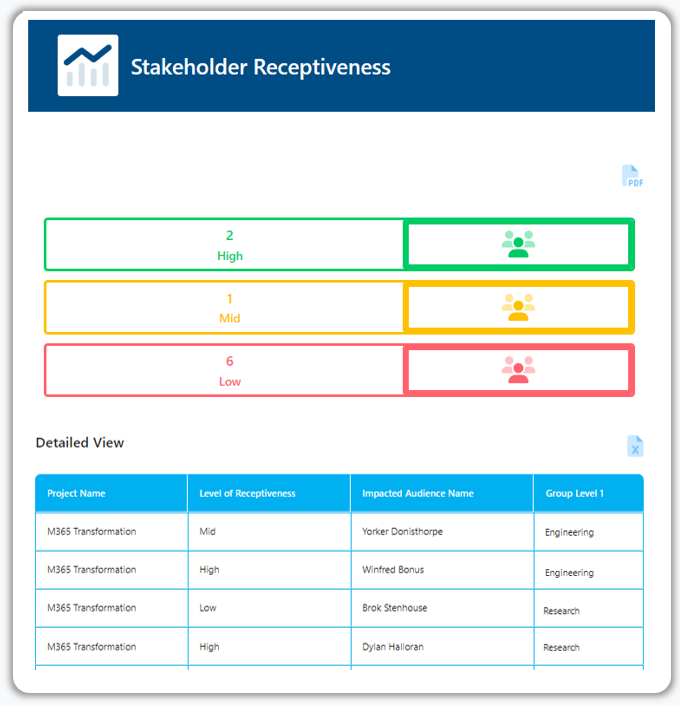
In OCMS Portal, you’ll find reports that help define stakeholder analysis results based on your internal stakeholder mapping. Try this comprehensive tool for conducting a stakeholder analysis for free. Start your free trial now.
Do you have any questions about how to define stakeholder mapping, stakeholder analysis assignments, stakeholder analysis government templates, or a power interest stakeholder map? Have you been looking for a stakeholder map template PPT, a tool for doing a detailed stakeholder analysis, or problem frame stakeholder map? Please reach out and let us know.
Now, let’s discuss a few of those key pieces of stakeholder mapping technique information and why it is important to gather them during your stakeholder analysis.
Stakeholder Analysis Steps: Stakeholder Types
You should separate your stakeholders by type, otherwise planning engagement is going to take you a lot more time, because whenever you look at your list of stakeholders, you’ll need to remember whether they’re a change agent, executive, manager, etc.
If you use a Stakeholder Analysis Tool that has a tagging system in your target audience for “stakeholder type,” you can easily classify your stakeholders by their type and then use that to sort and filter while planning and managing your engagement activities.
Illustration: stakeholder influence map
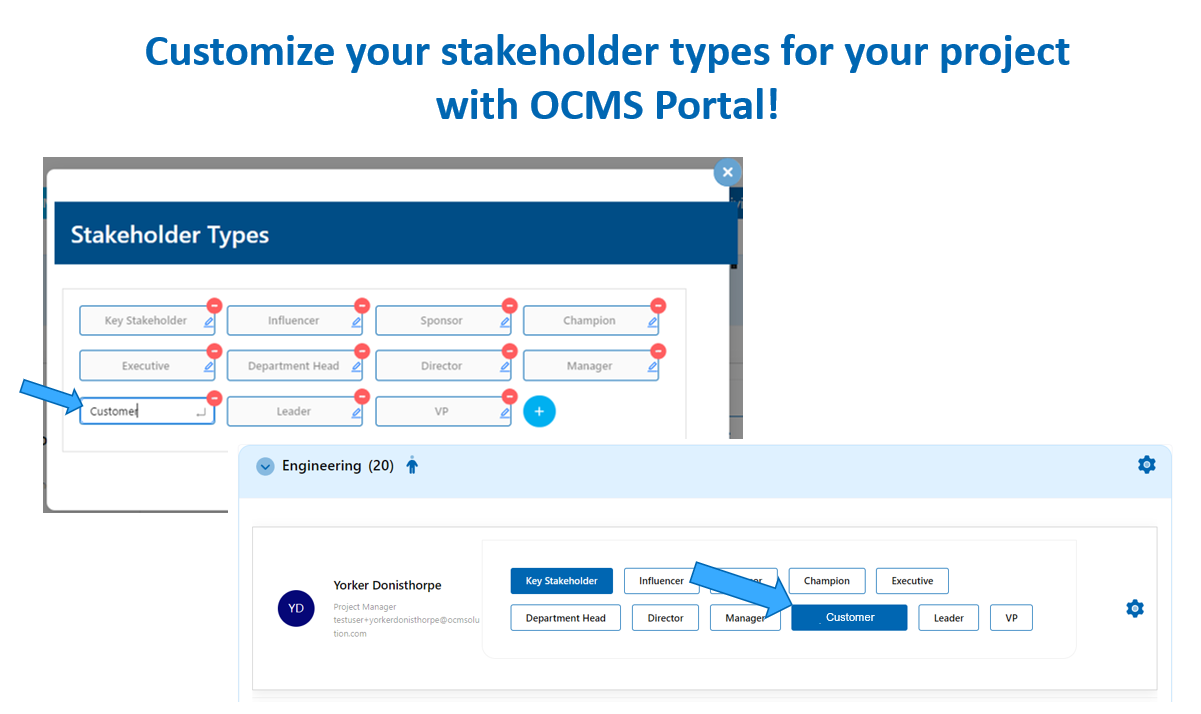
Sample stakeholder map template with a streamlined “Stakeholder Type” change management stakeholder mapping.
Stakeholder Analysis Steps: Ability to Impact the Project
Also, you will need to identify and map out each stakeholder’s ability to impact the project. This information on the stakeholder map will drive your engagement plan for each stakeholder and help you prioritize. For example, if a stakeholder that can significantly impact or halt a change is opposing the change, then you will need to implement a plan to gain that person’s buy-in and mitigate their opposition as soon as possible.
If you don’t know which stakeholders have a high, mid, or low ability to impact your project, then you’ll be leaving yourself wide open to be blindsided by a resistant stakeholder with a high ability to impact the project.
Don’t Miss: Tool for Creating Stakeholder Influence Maps.
Do you have any questions about conducting a stakeholder analysis, stakeholder communication analysis, or stakeholder map project management? Are you here looking for information about the ADKAR stakeholder analysis template, stakeholder engagement assessment matrix PMI, or a healthcare stakeholder map? Please reach out and let us know.
Stakeholder Analysis Steps: Level of Receptiveness
How receptive a stakeholder is to a project is a key driver for your engagement plan, which is why it’s important to use a scale for gauging the level of receptiveness to the change initiative in stakeholder management analysis.
This KPI is a key piece of information to be included in any stakeholder influence map and can also be cross-referenced with the ability to impact a project to identify the most critical stakeholders to engage with. For example, if a stakeholder has a high-level ability to impact a project and a low level of receptiveness to the project, you will want to plan a proactive engagement strategy to raise their level of receptiveness, so the project isn’t in danger of failing.
Illustration –
OCMS Portal Stakeholder Analysis Toolkit Interactive Report
One of the limitations when using a stakeholder analysis template PPT, stakeholder analysis template PDF, or free stakeholder mapping template Word doc is that they often won’t have the analytics that help you present data in an actionable format. Because of the importance of stakeholder mapping, it’s best to use a stakeholder map online, Excel tool, or project stakeholder analysis template that has reports built in (like OCMS Portal).
Stakeholder Analysis Steps: Determine Availability
You can’t assume that every stakeholder is going to have as much time as you’d like for their change engagement, coaching, training, and other change-related activities.
Some may already be overwhelmed with their job duties, while others may have more time to devote to the change project. Knowing a stakeholder’s available bandwidth for needed and desired change activities can help you plan more strategically.
For example, you may choose a stakeholder to be a change champion from those stakeholders with more availability. Knowing which stakeholders have low availability provides you with a “heads up” that you should find time-efficient ways to engage.
See Also: OCMS Portal’s Stakeholder Influence Mapping Software.
If a stakeholder hears from you upfront that you respect the fact that they’re busy and will work with their schedule as much as possible, you will have a better chance of getting them to accomplish the change tasks you need.
When you do a stakeholder analysis customers are included in, also consider the hours of operation of those businesses when planning things like a vendor orientation session or customer workshop to introduce a new system. If you have international clients, then your customer stakeholder analysis should also look at countries and time zones.
Stakeholder Strategy – What Can You do if a Stakeholder has a Lack of Availability?
- Put things together as much as possible for them, like communications you need them to cascade to their department. For example, instead of requiring the person to draft an email and then have you review it, your stakeholder plan for that person should involve just giving them the communication ready to go, and all they need to do is click “send.”
- Expect the change or project team to do more of the heavy lifting for this stakeholder. The stakeholder plan for this person may require more follow-up to ensure any assigned tasks are moving forward.
- Ask the stakeholder’s supervisor for pockets of time for them to perform some of the needed change activities. Be exact, such as “Could John get 1.5 hours this Thursday for a change-related training?” Do not just say, “I’m going to need more of John’s time during the project,” because this doesn’t give the supervisor enough detail for adjusting John’s workload. Gather all this information and enter it into this person’s stakeholder plan.
- You might enlist someone else in their department (e.g., an assistant) to help them with certain assigned stakeholder tasks.
Do you have any questions or feedback about our article on stakeholder map explained? Have you been seeking a simple stakeholder map, stakeholder analysis PowerPoint, mind map stakeholders template, stakeholder communication map or stakeholder engagement assessment matrix example? Please reach out and let us know.
Stakeholder Strategy – Details on Current Stakeholder Situation
During your stakeholder analysis, you may want to add a field on your stakeholder mapping template to summarize the stakeholder’s current situation. The person’s stakeholder plan will then be based on how to move the person from their current state to the future state.
On this area of your business stakeholder analysis, you’ll include the answers to questions like:
- Is the stakeholder resisting, supporting, or unaware of the project?
- Does the stakeholder have concerns about the project?
- Is the stakeholder a good candidate for taking on some of the project tasks?
- Does this stakeholder have control over the project’s budget or timeline?
- What needs to be known about this stakeholder?
Stakeholder Strategy – Details on How Success Will Be Measured
One of the other key pieces of information you need to decide for a person’s stakeholder plan is how you will measure successful engagement with the stakeholder. You don’t want the level of engagement success to be completely objective scoring. It’s important to include specifics in your stakeholder map tool.
For example, if you are using a “High,” “Mid,” and “Low” for tracking the engagement success level with a stakeholder, you need to define what high, mid, and low mean.
Try to use quantitative measurements along with qualitative information for your levels where possible. Quantitative would be a hard number measurement of something, like how many meetings were attended or how many tasks were accomplished. Qualitative is descriptive and more subjective, such as how positive a person is feeling about a change project.
It’s also better to have more than one measurement on your stakeholder map tool. This provides a more robust set of KPIs that cover multiple angles and reduces the risk of stakeholder engagement success being based upon just one person’s opinion.
As an example, you might define success measurements as:
- High = Stakeholder has no more reservations about the project and is fully supportive; and 4 out of 5 meetings have been attended.
- Mid = Stakeholder has some reservations but is willing to give the project a chance; and 3 out of 5 meetings have been attended.
- Low = Stakeholder is still resistant to the project and has objections; and less than 3 out of 5 meetings have been attended.
Taking the time to define your success measurements ahead of time will make your stakeholder strategy process go much faster and foster a more accurate assessment.
OR
Stakeholder Risk Scoring in a Stakeholder Analysis Approach
As a faster alternative to determining success metrics for a design thinking stakeholder map, you may want to use a Risk Level Score that is based on three common metrics:
- Level of Receptiveness
- Level of Influence
- Level of Availability
This method for mapping of community stakeholders in an organization can be automated, saving you time. The OCMS Portal’s stakeholder mapping matrix template automatically calculates a risk score for you and autogenerates a stakeholder engagement plan once you do the change management stakeholder assessment.
Illustration –
OCMS Portal’s Stakeholder Impact Analysis & Management Tool
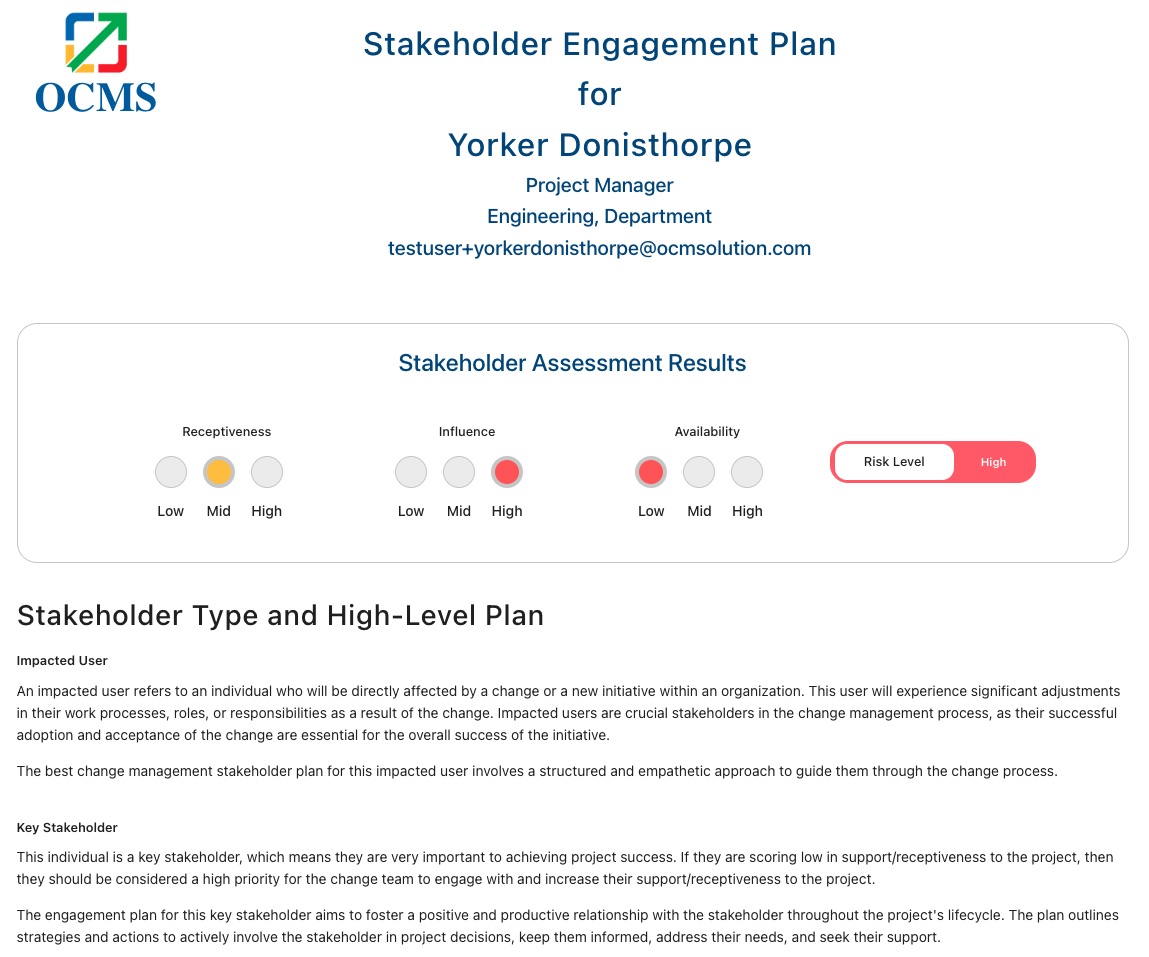
Stakeholder impact analysis example of an autogenerated risk level and engagement plan from OCMS Portal. Try this stakeholder mapping tool free today by signing up for a trial.
Have you been looking for a stakeholder map generator, stakeholder analysis example case study, stakeholder analysis matrix Excel template, stakeholder mapping template Excel free tool, or stakeholder analysis example PPT? Do you have questions about project manager stakeholder analysis, stakeholder analysis strategic management, or an example of stakeholder analysis matrix? Please reach out and let us know.
Organizing Your Stakeholders Impact Analysis Information
All of the information about your stakeholders needs to be gathered as part of your stakeholder mapping and entered into your OCMS Portal Stakeholder Mapping Matrix Template, or another stakeholder analysis matrix template Excel tool or cloud tool of your choice.
Using a stakeholder analysis template is very important because it allows you to effectively coordinate all aspects of your stakeholder mapping and assessment. But you want to make sure you’re using one that has the features you need and supports a streamlined workflow.
Many change practitioners are held back because they’re using inefficient tools for the purpose of stakeholder analysis. Things to look for in a good stakeholder analysis chart template include:
- Simple and easy to use
- Built-in-surveys
- Autogenerated risk score
- Autogenerated engagement plan
- Based on OCM best practices
- Analytics and reporting
To get all these features and more, you can use OCMS Portal’s #1 Ranked Stakeholder Management Tool. This tool is an online change manager that is designed to help you plan, manage, and execute a successful stakeholders impact analysis, engagement, and management change project. Get interactive, real-time analytics and stakeholder assessment samples to ramp up the learning curve on your stakeholders impact analysis.
Do you have any questions about stakeholder analysis example healthcare, stakeholder power analysis, stakeholder mapping example company samples, or a stakeholder mapping example in healthcare? Please reach out and let us know.
Illustration –
OCMS Portal Reporting for Stakeholder Template for Managing Data
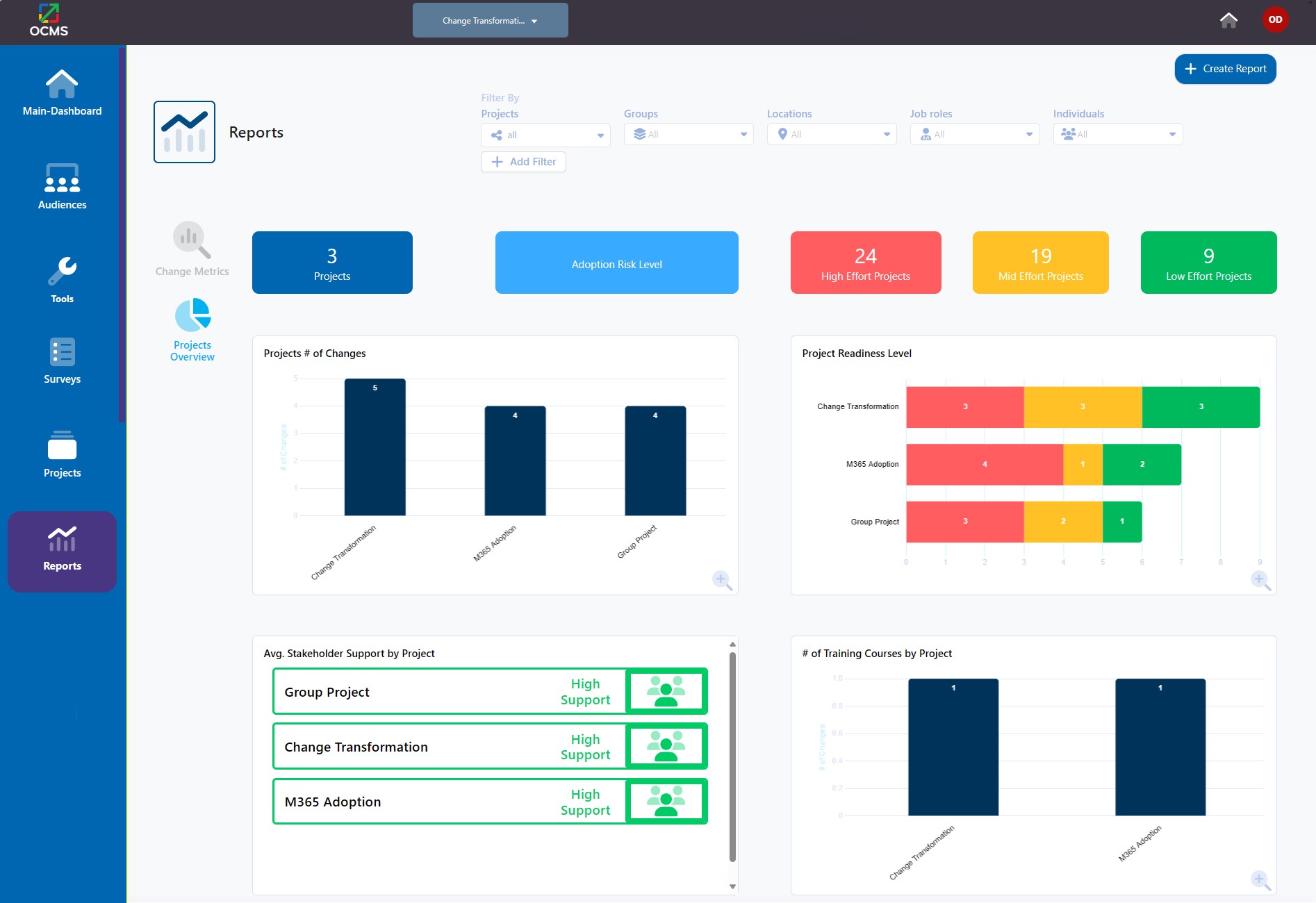
Example of reporting that shows stakeholder analysis importance. Get Your Copy of the OCMS Portal Stakeholder Analysis Mapping Tool by signing up for a free trial today.
You can save time with this ready-to-go template for gathering your organizational stakeholder and key stakeholder information.
Advantages of using this tool for your stakeholder impact analysis:
- Simple to use, comprehensive interface
- Autogenerated stakeholder engagement roadmap
- Add or modify fields to customize the stakeholder engagement mapping template
- Instant analytics with robust reporting from your stakeholder impact map
- Filter your data to uncover deeper insights on stakeholder analysis purpose
- Easily glean a holistic view of overall receptiveness
- Quickly see which stakeholders have high risk scores
- Work on more than one project at a time & easily switch between them
- See how different change initiatives are impacting your stakeholders
- Cloud-based, work from any device and do your stakeholder analysis online
- Enterprise-class security, automatic backups, guest accounts, and more
OCMS Portal with Stakeholder Assessment & Management Tool, Plus End-to-End OCM Process.
Why Stakeholder Mapping is Important
A stakeholder mapping assessment template allows you to document and determine each stakeholder’s level of commitment to the change (negative or positive), so you can effectively plan on how best to enlist their buy-in and support, or how to mitigate their opposition to the project.
A stakeholder mapping matrix also allows you to identify impacted groups that have no key stakeholder leaders. Using this information, you can then engage program sponsors and other project stakeholders to help you solicit more support for those impacted groups.
In most cases, we need stakeholders to help advocate for the project. Being an advocate involves wearing many hats including helping to reduce resistance, working with other senior executives to promote the program, helping to disseminate communications, and more.
Without a stakeholder assessment, you have no direction for your change project as to the people it is impacting. The whole point of change management is to guide people successfully through a change by using various engagement methods (communication, coaching, training, 1:1 discussion, etc.). So, the purpose of a stakeholder analysis is to provide that direction.
The influence stakeholder mapping and visualization has helps OCM teams effectively plan and deploy their change management support for a project and do so in a targeted approach.
To do that, you first need to identify and assess the stakeholders you’ll be guiding through the change. This is what’s done in the stakeholder assessment and why effective stakeholder analysis in project management is a bedrock of your change management strategy.
Are there stakeholder analysis example PDF templates, a stakeholder map free template, or Prosci stakeholder analysis template that you have used in the past and would like to provide feedback on? Please, let us know.
Do you have questions about community stakeholder mapping, how to do a mind map of stakeholders, stakeholder analysis winning support for your projects, how a stakeholder analysis can help the team leader, or a stakeholder map interest influence chart? Just reach out. We’ll be happy to help.
Determine the WIIFM for Each Stakeholder/Group
One of the most important things for a change manager to know and be able to express to stakeholders is the “What’s In It For Me” (WIIFM). In other words, what’s in it for them, how will they benefit?
People often oppose a change because they don’t see how they or their department/organization is going to benefit from it.
They may think one or more of the following:
- “This is just going to mean more work for me!”
- “Things are fine the way they are.”
- “I don’t understand what this change is supposed to accomplish.”
- “Is all this disruption during the change process going to be worth it?”
As a change manager doing stakeholder analysis research, your job during stakeholder engagement is to tell them their WIIFM (i.e., what the benefits of this change will be to them and their department, coworkers, etc.)
You can find this information by accessing details in the project assessment and by interviewing sponsors and other leaders that were involved in initiating the project. The WIIFM will be invaluable to you when completing the various steps for stakeholder analysis and management.
See also: OCMS Portal’s Stakeholder Analysis in Project Management Tools.
The WIIFM may be different for different stakeholders, groups, and job roles. So, you’ll want to document this in your stakeholder template that you’re using for stakeholder analysis to associate each WIIFM with each stakeholder.
Do you have any questions about a stakeholder mind map, or stakeholder template for planning engagement tasks, or a stakeholder engagement assessment matrix template? Are there stakeholder analysis example pdf templates that you have used in the past and would like to provide feedback on? Please, let us know.
Planned Tasks & Strategy for Engaging Stakeholders
The next step for your stakeholder mapping and assessment exercise will involve planning your engagement strategy with the stakeholder and assigning and tracking tasks.
These will be tasks for the person responsible for engaging with a stakeholder as well as any tasks you may assign the stakeholder themselves.
For example,
Say you have a stakeholder that is not very happy about the change project because they are so busy already that they dread having to learn a new process and way of doing things.
Some tasks for your change management team may be:
- Meet with the stakeholder’s supervisor to discuss giving them some time in their week for a training session.
- Review change management planning documents (like the project assessment) to gather a list of bullet points of WIIFM (What’s In It For Me) to present to the stakeholder.
- Meet with the stakeholder to go over the ways they will end up saving time and benefitting from the change.
Some tasks for the stakeholder may be:
- Attend a 2-hour training session on the new process.
- Send the change management team a list of concerns they still have after attending the training.
See also: OCMS Portal Stakeholder Analysis in Project Management Tools.
Please contact us if you have anything you’d like to share about a visual stakeholder map, stakeholder analysis construction project planning, or what your typical stakeholder mapping categories include. You can also reach out if you have any questions about the stakeholder mapping change management process, stakeholder analysis sustainability projects, a stakeholder analysis quadrant, or stakeholder analysis NHS improvement.
Typical Tasks for a Stakeholder
What types of tasks does a change manager typically assign a stakeholder they’re managing?
To understand that let’s briefly discuss the role of a typical stakeholder. They are usually representatives of an impacted group, meaning the entire group is not getting the same engagement level that you have with the stakeholder.
Thus, stakeholder activities examples will often involve waterfalling communications throughout their group/department/area, providing details on any resistance in their group, etc. They are a representative of the group.
Some of the typical tasks assigned to stakeholders include:
- Assigning a communication and asking them to waterfall it down to others
- Asking them to engage with other stakeholders to build support for the project
- Asking for their help to engage with employees that are resistant to getting their buy-in and support
Enter the task information into your editable stakeholder engagement risk assessment plan in the OCMS Portal Stakeholder Assessment Matrix and Template.
You’ll want to include task tracking as well, including columns for:
- Task(s) due date
- Who the task(s) is assigned to
- Whether or not task(s) has been completed
Illustration –
OCMS Portal with Stakeholder Template and Project Tasks Checklist
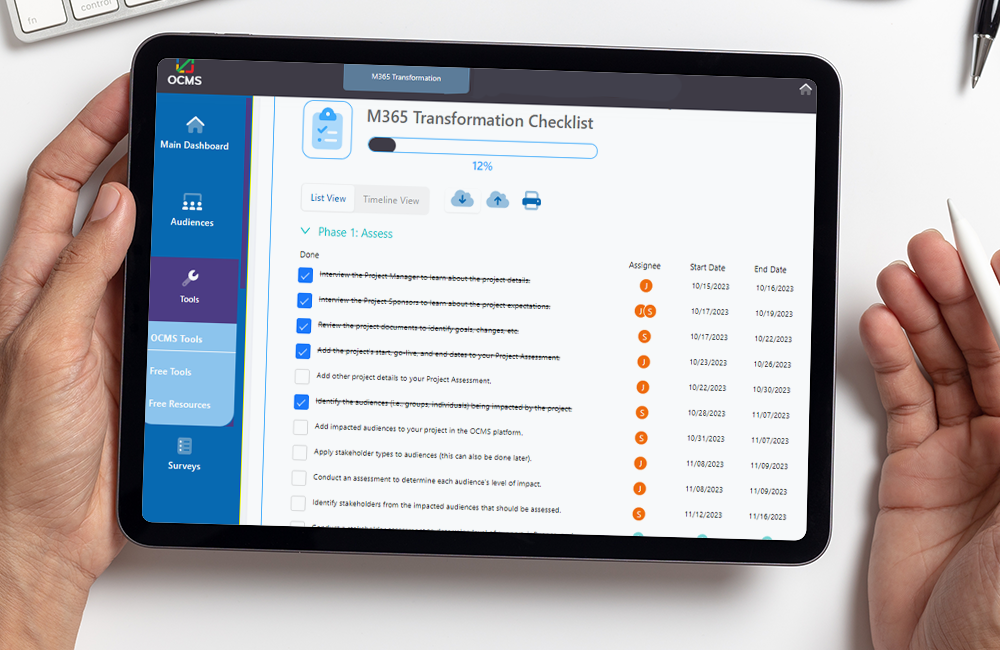
Interested in a stakeholder mapping template excel download or stakeholder analysis table? Click here to read more about the OCMS Portal stakeholder analysis matrix examples and project mapping designs for assessing key stakeholders in a project.
Do you have any questions about how to map various stakeholders at workplace concerning communication management, creating a key stakeholder map, or a stakeholder analysis template example? Please reach out and let us know.
Also reach out if you’re looking for a better way to create stakeholder map online, do stakeholder mapping in healthcare, conduct stakeholder analysis in policy making, do a government stakeholder analysis, or conduct a stakeholder analysis suppliers and customers are included in.
Why You Should Coach Key Stakeholders and Sponsors
The influence that a key stakeholder has on his or her employees and direct reports is immeasurable for reducing resistance and increasing end-user acceptance of the change, which is why change and program management practitioners need to implement an effective coaching strategy, as reviewed below.
Oftentimes, sponsors and key stakeholders have little to no experience with effective change management practices. Part of your role will then be to coach them on the best change practices. Learn more about coaching stakeholders, sponsors, and managers.
To be effective sponsors, key stakeholders need to understand how vital they are to the success of the change initiative, including understanding their role in helping with communications, resistance management, engagement, and reinforcing the change.
In coaching managers and supervisors to become effective managers of change, your change management coaching plan will need to apply a multi-step approach. Click here to see a detailed coaching plan strategy that you can leverage for coaching key stakeholders.
See also: OCMS Portal stakeholder analysis matrix examples, samples, and templates
Engage and Manage Stakeholders
Click here to review a separate article that we published which covers the process for engaging and managing stakeholders.
This article continues the stakeholder analysis business process, continuing into the engagement and management phases.
Do you have any questions about power and interest stakeholder analysis, a stakeholder analysis graph, or stakeholder mapping influence interest? Or are you looking for a stakeholder mapping Excel template, stakeholder map PowerPoint, stakeholder map template free download, PMP stakeholder engagement assessment matrix, or stakeholder analysis template free? Please reach out and let us know.
How Do You Measure Stakeholder Support, Availability, etc.?
Stakeholder surveys are an excellent way to capture the necessary KPIs for your stakeholder analysis. You can survey stakeholders directly or those who manage the stakeholder.
One of the most effective ways to survey stakeholders is through an online form tool, such as the built-in forms in the OCMS Portal’s stakeholder impact assessment template. This makes it easy for users to fill out on any device, and the answers come in instantly to the Change Management Team, no having to collate several documents that have come in by email. You can easily export it as a stakeholder analysis PDF file to share with project leaders, sponsors and executives.
Illustration –
OCMS Portal’s Stakeholder Toolkit & Stakeholder Analysis Table Includes Free Surveys to Capture KPIs
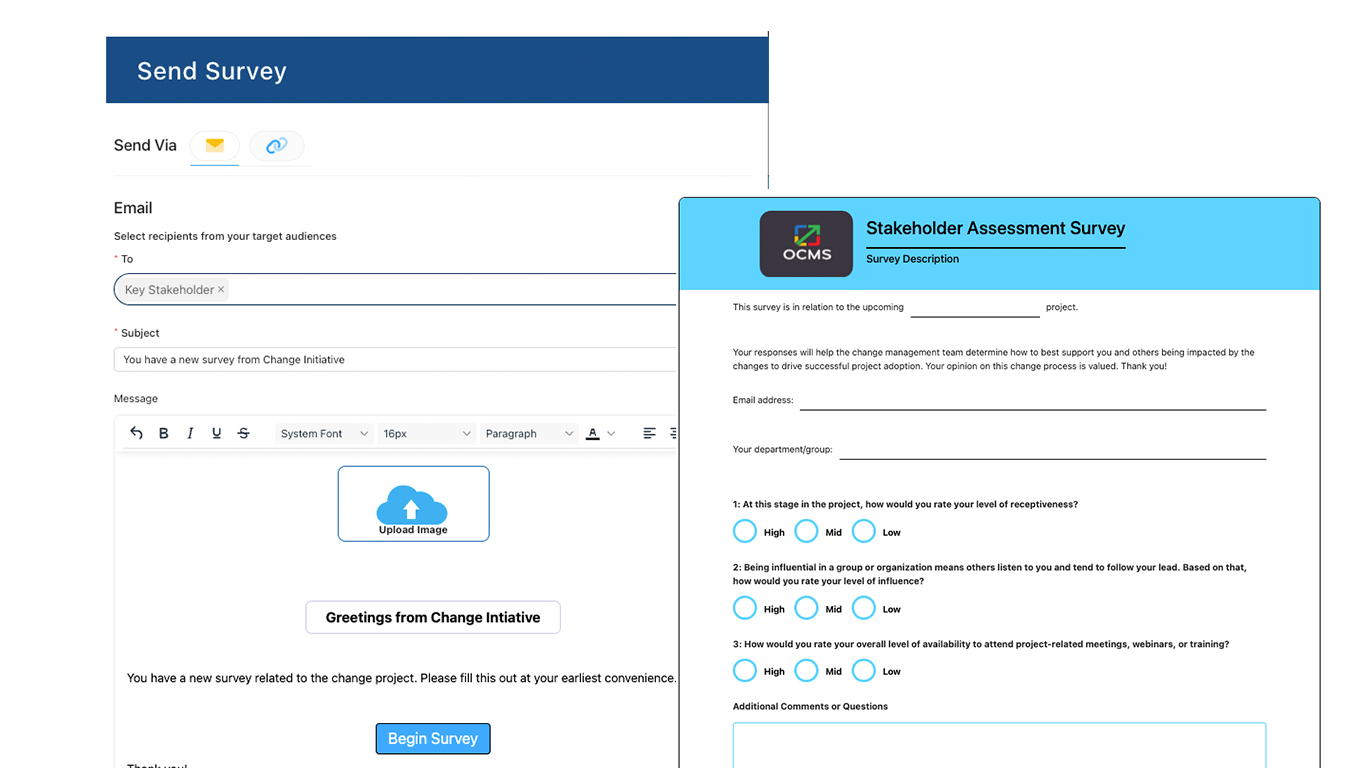
Whether you’re doing a marketing stakeholder analysis, a HR stakeholder analysis, NHS stakeholder map, or policy stakeholder analysis, the built-in surveys in the OCMS Portal save you hours of work, by collecting key data and populating it into your reporting and stakeholder mapping chart automatically. Try it for free today.
Is there a best stakeholder analysis model that you have used that you would like to share with other project managers and change leads? Would you like more details on stakeholder impact analysis steps, project management stakeholder analysis templates, a stakeholder needs analysis example, or stakeholder engagement assessment matrix PMP? Please, reach out and let us know.
Change Management Stakeholder Assessment Tool & Templates
When conducting your stakeholder analysis, it is imperative that you use software, a stakeholder management tool, or a stakeholder management spreadsheet to document stakeholders, their impact levels, their level of support or resistance for the change, and other information.
Some of the options you’ll find online may be:
- Stakeholder mapping tool Excel
- Stakeholder influence map template
- Stakeholder mapping ppt template free
- Excel stakeholder analysis template
- Online stakeholder map maker
- Word stakeholder analysis worksheet
- Stakeholder analysis matrix PDF
- Free stakeholder analysis template
- Stakeholder analysis matrix template Word doc
- Stakeholder mind map template
- Editable stakeholder mapping template free
- Stakeholder analysis quadrant worksheet
- Stakeholder analysis power interest template
- Basic stakeholder analysis PDF
- Stakeholder mapping in design thinking tool
- Stakeholder analysis xls download
- Stakeholder analysis quadrant document
- Stakeholder analysis report template
- Stakeholder mapping power and interest worksheet
The point is that there are lots of tools to use to make stakeholder map templates. So, what’s the best stakeholder mapping tool?
According to Change Practitioners around the world, it OCM Solution’s OCMS Portal with Stakeholder Assessment & Management Tool includes a best-in-class stakeholder management database template, samples, a 360-degree analytics view of impacted groups, and much more that you can leverage to simplify and optimize your change management tasks. It’s a powerful yet simple stakeholder analysis template.
Why do change management professionals tell us they love our tools for stakeholder mapping? Because OCMS Portal makes building a stakeholder map simple and easy. This includes visualising and mapping stakeholder influence in a few clicks. You also never have to stare at a blank stakeholder map. Once you enter your impacted target audience and tag your key stakeholders, these automatically populate into the stakeholder analysis form.
Illustration –
OCMS Portal’s Stakeholder Analysis Map Template
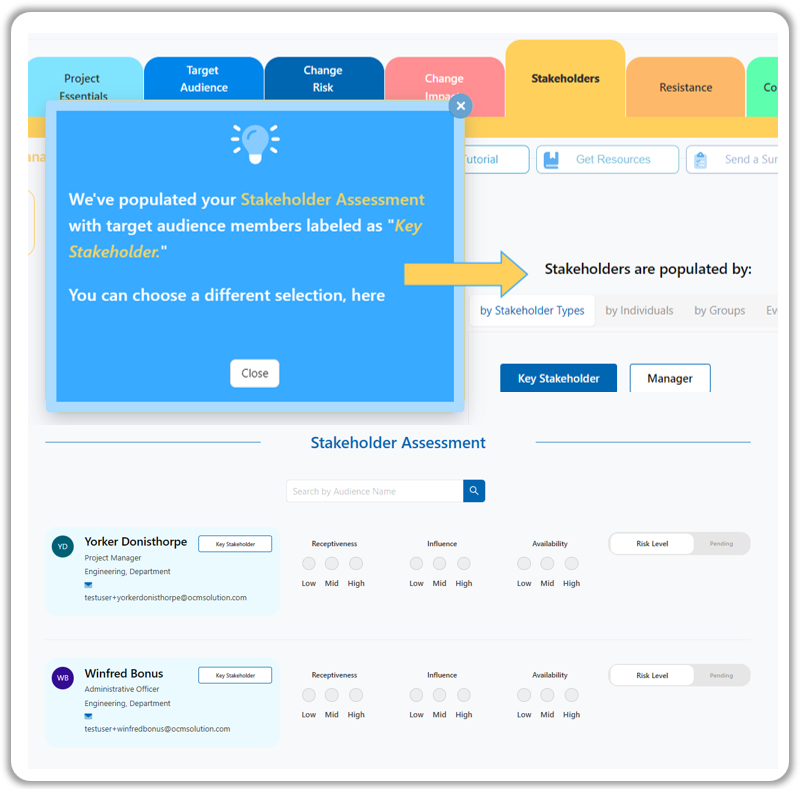
Save tons of time with the simple-to-use stakeholder process mapping tool in OCMS Portal.
Illustration –
Stakeholder Analysis Interactive Reports & Analytics
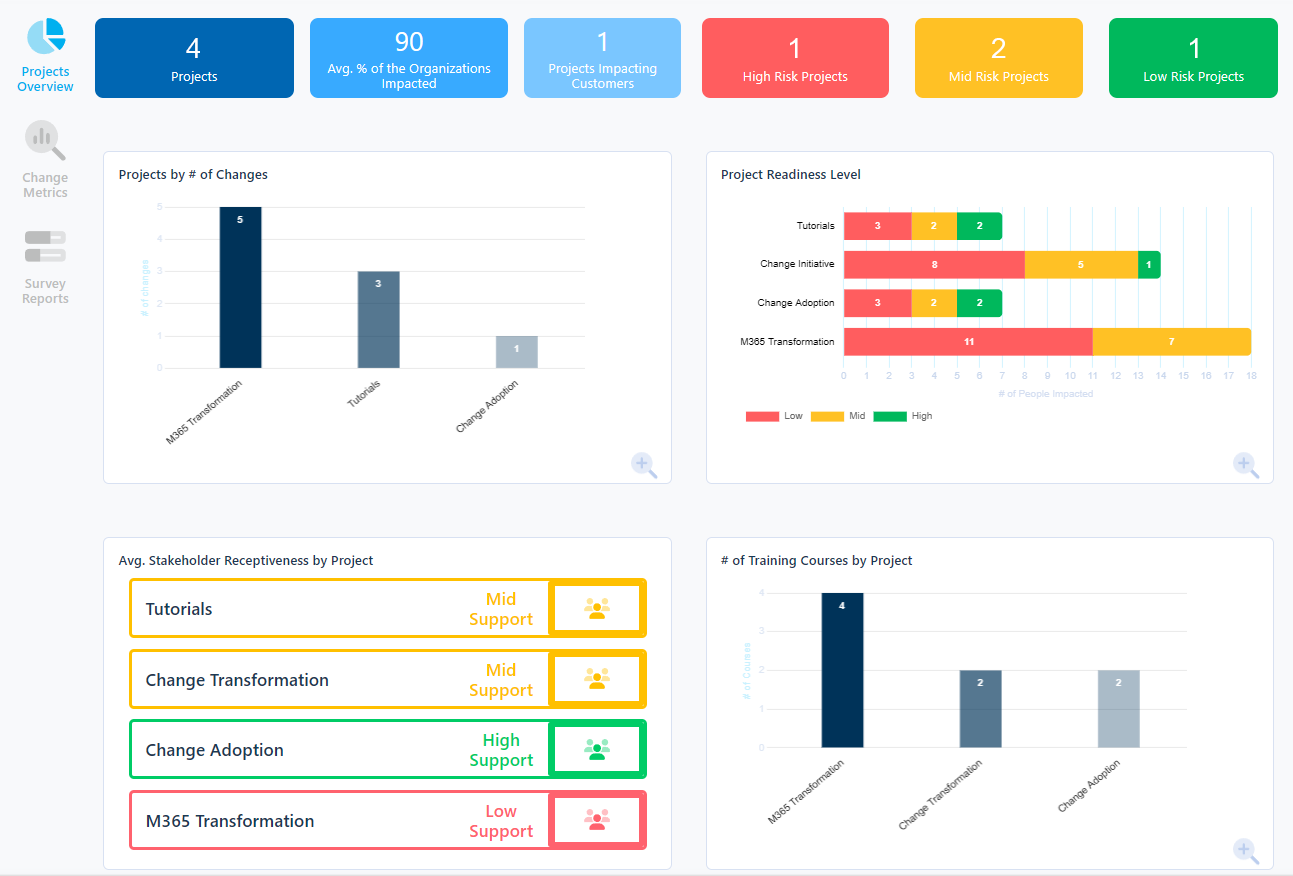
OCMS Portal is a full-featured cloud platform to help you plan, manage, and execute a successful change project, end-to-end, whether this is your first change project or your one-hundredth. You can choose from multiple change tools, including the Stakeholder Management Toolkit, and you can also export your reporting data as a stakeholder analysis pdf file report to share with project leaders, sponsors, and executives.
A benefit of the OCMS Portal stakeholder analysis in change management software is that you can work from a centralized list of individuals and groups from your target audience list. These are also used to populate other templates (communications, training, etc.). This simple stakeholder analysist template process helps you get a holistic view of how projects are impacting the people and groups in your organization.
Click below to start your free trial and for instant access that will allow you to get started right away.
FAQ: Stakeholder Mapping Strategy
Stakeholder analysis is the process of assessing the stakeholders for a project or change. Stakeholder analysis is a critical component of effective project and change management because it increases the success of your stakeholder engagement and management. Read more in this article
When starting out your stakeholder analysis, your first step will be spent in gathering your list of key stakeholders. This list will include managers, senior managers, business leaders, employees, executives, and others that have or might have a stake in the business or technology change. Read more...
A stakeholder analysis is very because allows you to document and determine each stakeholder’s level of commitment to the change (negative or positive), so you can effectively plan on how best to enlist their buy-in and support, or how to mitigate their resistance. Read more...
A stakeholder analysis matrix is used to document information on stakeholders. It includes columns for documenting each stakeholder's level of commitment to the change (negative or positive), so you can effectively plan on how best to enlist their buy-in and support, or how to mitigate their resistance. Read more in this article
In most cases, we need stakeholders to help advocate for the project. Being an advocate involves wearing many hats including helping to reduce resistance, working with senior executives to promote the program, helping to disseminate communications, and more. As such, we also need to assess each stakeholder’s change management knowledge and experience and include that information in a stakeholder mapping matrix. We will discuss this in more detail above.
Stakeholders help advocate for a business change or project. Being an advocate involves wearing many hats including helping to reduce resistance, working with other senior executives to promote the program, helping to disseminate communications, and more.What is Stakeholder Analysis?
How do you perform a stakeholder analysis?
Why is a stakeholder analysis important?
What is a stakeholder analysis matrix and how is it used?
What are the roles and responsibilities of a stakeholder?
What Are the Functions of a stakeholder?
Note: Content on OCM Solution's ocmsolution.com website is protected by copyright. Should you have any questions or comments regarding this OCM Solutions page, please reach out to Ogbe Airiodion (Change Management Lead) or the OCM Solutions Team today. OCM Solution was previously known as Airiodion Global Services (AGS).
External source: Stock.adobe.com, Microsoft 365 Clip Art Image(s) (Bing images licensed under the Creative Commons license system.), https://www.ls.graphics/free/free-pixel-4-and-pixelbook-go-mockup




